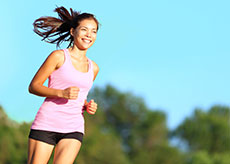
The environment in which you work out should be a factor in what you wear, and how you structure your activity.
When the temperatures start to soar, it’s important to remember that an outdoor exercise session will put extra stress on your body.
“Staying active year-round is important, but warmer weather calls for a few extra considerations,” says JoJo Goulding, Health and Wellness Director at the Southdale YMCA. “With the right preparation and a little flexibility, you can enjoy your workouts safely all summer long.”
What to wear
Jojo recommends wearing clothing made of moisture-wicking fabrics that help pull sweat away from your skin and keep your body cool. Lightweight, breathable, and light-colored fabrics are best. You’ll also want to consider the type of activity you’ll be doing to determine what you wear.
How to structure your workout
- Scale: A workout in hot and humid weather is already going to be one of your hard workouts for the week, even if it’s your usual routine. Listening to your body might mean slowing down your pace or shortening your session.
- Time: Plan outdoor workouts for early morning or evening, when temperatures are cooler. Avoid the midday heat—especially between 10 a.m. and 4 p.m.
- Location: Choose shaded areas whenever possible. Think yoga under a canopy, or a run on a forest trail with tree cover.
- Hydration: “Staying hydrated is crucial,” says Jojo. “Plan ahead by drinking 16 ounces of water 1-2 hours before your workout, then continuing to rehydrate every 15 minutes while you’re active.” Keep in mind that the more you sweat, the more you need to drink. Even when there’s lots of moisture in the air (humidity), your body is still losing fluid via sweating.
Signs you might be overdoing it in the heat
If you push too hard in hot and humid conditions, your body may struggle to cool itself. Warning signs that your body is overheating include:
- Heat cramps: Painful muscle spasms that can happen during or after intense activity in the heat.
- Heat exhaustion: Heavy sweating, rapid pulse, fatigue, and nausea. If not addressed, this can lead to heatstroke.
- Heatstroke: A serious medical emergency marked by a body temperature of 104°F or higher. Without quick treatment, it can cause damage to the brain, heart, kidneys, and muscles.
The Mayo Clinic also recommends watching for:
- Cool, moist skin with goose bumps while in the heat
- Dizziness or feeling faint
- Nausea or headache
- Fatigue
- Flushed skin
- Rapid breathing
How the heat can help
While it’s important to be cautious, heat isn’t always a drawback. JoJo notes that exercising in warmer temperatures can offer some unique benefits.
“When your muscles are warm, you may find greater flexibility and range of motion,” she says. “And because your body is working harder to cool itself, your workout can feel more intense—even without changing your routine.”
This is part of the appeal of hot yoga, where elevated temperatures can help deepen stretches and enhance focus on the mind-body connection.
Balance is key
Outdoor workouts can be a great way to enjoy the season—whether you’re hiking, swimming, or going for a run. But during stretches of extreme heat, JoJo recommends mixing in indoor sessions to give your body a break from the sun.
“It’s not about avoiding the outdoors altogether,” she says, “but being smart about how and when you’re active. If the only time you can exercise is during the hottest part of the day, choose an indoor workout instead.”
With climate-controlled fitness centers, pools, and group classes, the Y offers plenty of ways to stay active—no matter the weather. With a little planning and flexibility, you can keep moving and stay safe all summer long.